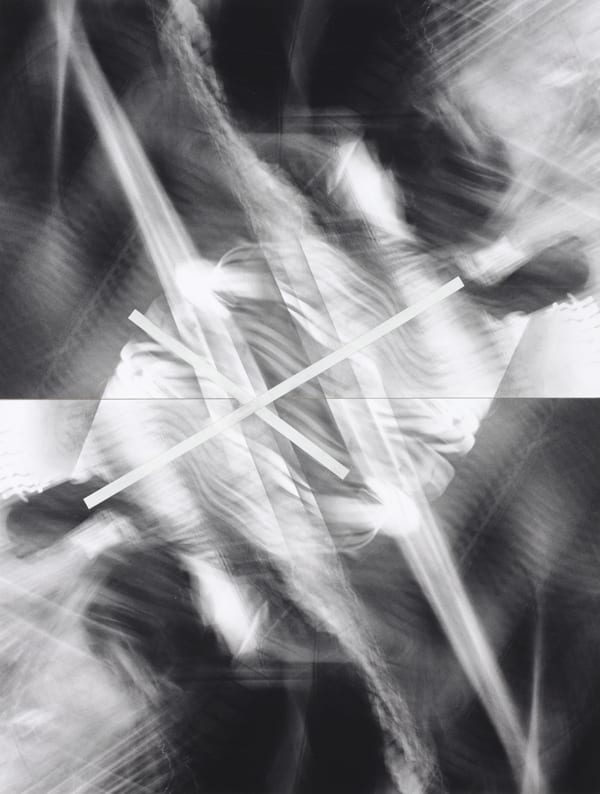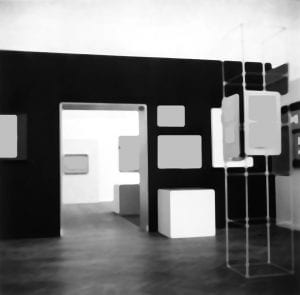
- This event has passed.
ABSTRACTION X7

In conjunction with Joan Mitchell (1925-1992): An American Master, LUAG presents two exhibitions that survey the possibilities of abstraction as interpreted by select 20th and 21st century artists from the LUAG Teaching Collection, ABSTRACTION X 2 and ABSTRACTION x7. Exploring varied ideas of collage, found imagery, mark making and digital manipulation, each artist embodies an individual point of view within the broad and shifting spectrum of abstraction.
Mark Tobey (1890-1976)
Mark Tobey was an American painter. His densely structured compositions, inspired by Asian calligraphy, resemble Abstract Expressionism, although the motives for his compositions differ philosophically from most Abstract Expressionist painters. As a founding member of the Northwest School, Tobey shared the movement’s interest in philosophy and Eastern religions. In 1918, Tobey encountered the literature of the Bahá’í religion and later converted. Throughout his career, Tobey explored the representation of the spiritual in art.
Tobey is most famous for his creation of so-called “white writing” – an overlay of white or light-colored calligraphic symbols on an abstract field which is often itself composed of thousands of small and interwoven brush strokes. This method, in turn, gave rise to the type of “all-over” painting style later made famous by Jackson Pollock. Pollock first encountered Tobey’s work in 1944, and studied it closely. He was very interested in Tobey’s idea of covering the entire canvas with marks up to and including its edges. Pollock saw all of Tobey’s New York exhibitions and was inspired by his work, creating twelve by nine foot paintings, pouring and dribbling paint onto the canvas instead of brushing it on.
Aaron Siskind (1903 – 1991)
Aaron Siskind was an American photographer, working in both New York and Chicago. He often produced images in homage to Abstract Expressionist painting. Siskind’s work focused on the details of nature and architecture. He presented them as flat surfaces—new images which, he claimed, were independent of their original sources.
Early in his career Siskind was a member of the New York Photo League. Working with that group, Siskind produced several significant socially conscious series of images in the 1930s. Among them, “Harlem Document” remains the most famous.
In 1950 Siskind met Harry Callahan when both were teaching at Black Mountain College, North Carolina, in the summer. Later Callahan persuaded Siskind to join him as part of the faculty of the IIT Institute of Design in Chicago (founded by László Moholy-Nagy as the New Bauhaus). In 1971 he followed Callahan (who had left in 1961) to teach for the rest of his life at the Rhode Island School of Design.
Conrad Marca-Relli (1913-2000)
Marca-Relli was an American artist who belonged to the early generation of New York School Abstract Expressionists. Along with Jackson Pollock, Willem De Kooning, Franz Kline and others, Marca-Relli helped define the leading art movement of the postwar era.
On a trip to Mexico in 1953, he was impressed by the contrasts he observed between the white adobe buildings and the black shadows created by the luminous sun. Marca-Relli was completely consumed by this sight and—according to some stories— when he ran out of paint, he began gluing together material and paper. He imme diately found that collage provided the density and texture he sought. These early collages were created from segments of either raw canvas or natural linen, cut out with razor blades. They were pinned to the supporting canvas after being coated with a mixture of paint and glue. Soon he introduced volumes of color to his work.
By 1960, his collages were completely nonobjective. He had moved from the pliability of canvas to more resistant materials such as wood, metal and plastic. This gave his work an industrial appearance. He condensed his colors and forms to convey his belief in the duality of negative and positive forces.
Gordon House (1932-2004)
In the late 1950s, informed by the new art emerging in America and that of his contemporaries in England, Gordon House began to create large-scale abstract works. In a catalog introduction to House’s work, Richard Smith writes: “His paintings are like the momentarily in-focus forms of the daily-recurring landmarks of the Kings Cross-Welwyn Garden City route. The bright white space in which they exist is a non-atmospheric dazzle; the landscape has been burnt out by speed…the image in House’s painting is big within the canvas area, over-exposed, making it loom toward one, close as a tunnel wall. It is as if they had only a second to register, like signs on the new motorways.”
House was an active participant in the vibrant London art scene of the 1960s, regularly attending lectures, exhibitions and discussions. He and other artists, united by a common admiration for American Abstract Expressionism, were frustrated by the lack of exposure given to large-scale abstract works in commercial galleries. They organized their own exhibitions which they called ‘Situations.’ The name was derived from the participants’ idea that an abstract painting that occupied the whole field of vision would involve the spectator in an ‘event’ or ‘situation’.
He produced his first prints in 1961, and was instrumental in starting a printmaking revolution in Britain. Together with Cliff White, House set up the White Ink print studio in London, where he produced etchings and wood engravings on a series of antique printing presses he had collected. White Ink soon gained a reputation for innovative and high quality printmaking, attracting artists such as R. B. Kitaj, Richard Smith, Joe Tilson, Sidney Nolan, Victor Pasmore, Eduardo Paolozzi, Bernard Cohen and Elizabeth Frink.
Ralph Gibson (b. 1939)
An American photographer best known for his photographic books, Ralph Gibson creates images that often incorporate fragments with erotic and mysterious under tones, building narrative meaning through contextualization and surreal juxtaposition. He has worked exclusively with the Leica camera for almost fifty years.
Gibson studied photography while in the US Navy and then at the San Francisco Art Institute. He began his professional career as an assistant to Dorothea Lange and went on to work with Robert Frank on two films. Gibson has maintained a lifelong fascination with books and book-making. Since the appearance in 1970 of “THE SOMNAMBULIST”, his attention has been steadily drawn towards the printed page. To date he has produced over forty monographs, including “State of the Axe” published by Yale University Press in Fall of 2008 and “NUDE” by Taschen (2009). His photographs are included in over one hundred and fifty museum collections around the world, and have appeared in hundreds of exhibitions.
María Martínez-Cañas (b.1960)
In her work, Martínez-Cañas manipulates elements of personal and public history, morphing visual information from sources as diverse as family portraits, pre-Columbian sites and Cuban stamps. Her work takes many forms, including cubistic photo-based collages, cameraless photograms, assemblages, and conceptual installations.
Born in Havana, Cuba in 1960, Martínez-Cañas grew up in Puerto Rico and later moved to the United States. It was here that she developed her photographic awareness and intensive studio practice.
In the series “Adaptation” (2006), Martínez-Cañas makes use of photographs taken by lawyer-critic-curator José Gómez-Sicre, a Cuban-born advocate of Latin American modernism and a close family friend. In “Adaptation,” Martínez-Cañas digitally altered Gómez-Sicre’s photographs of museum and gallery painting installations, replacing the framed artworks with blank panels. The series is both an homage and an act of defiance; the cultural father figure’s images are embraced, but his points of focus eradicated.
Peter Berg (1948-1997)
Peter Berg was an American conceptual sculptor. Working in a Post-Minimal style, he created large-scale installations on the theme of architectural space. These installations often included architectural renderings and photographs directly related to the construction, documentation, and conceptual intentions of each installation. In addition, like many artists of his generation, Berg often included temporal and performative elements in his work. The works were realized as temporary installations and dismantled at the close of each exhibition. Some projects were never realized and exist only as plans in the form of drawings.
Berg also made vibrant abstract drawings, many of them large scale, that were interpretive of his architectural ideas. In addition, he produced a separate body of work (seen in this exhibition) consisting of collaged photo abstractions. These works were made during the later part of the artist’s career and were not shown or sold during his lifetime.






